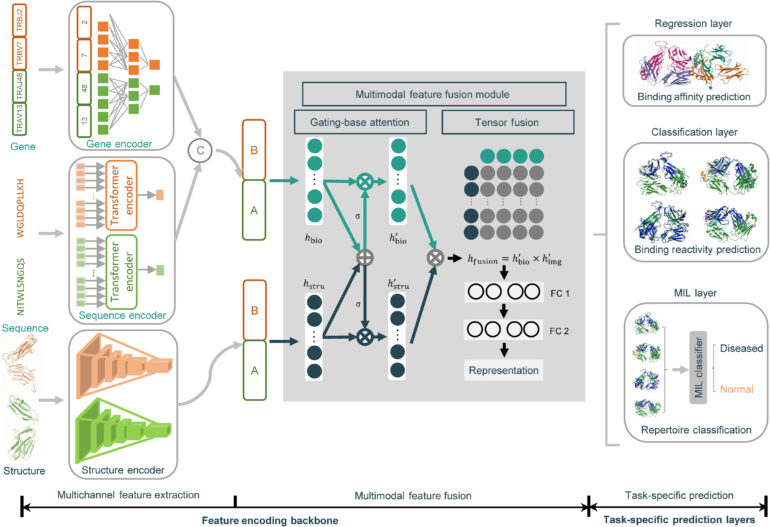TL;DR:
- DeepAIR integrates genetic sequence and structural data for advanced immune receptor analysis.
- Current methods struggle to accurately predict immune receptor binding strength.
- DeepAIR leverages AlphaFold2’s structural predictions, achieving high accuracy.
- It boasts a Pearson’s correlation of 0.813 for TCR binding affinity prediction.
- Impressive median AUC values of 0.904 and 0.942 for TCR and BCR binding reactivity.
- DeepAIR identifies specific diseases like nasopharyngeal carcinoma and inflammatory bowel disease.
- This breakthrough promises precision medicine and enhanced disease management.
Main AI News:
In the realm of scientific exploration, few frontiers have proven as elusive and enigmatic as the human immune system. Understanding how it identifies and combats infections and diseases has posed an enduring challenge for researchers. At the heart of this intricate biological machinery lies the pivotal interaction between adaptive immune receptors (AIRs), such as T cell receptors (TCRs) and B cell receptors (BCRs), and their corresponding antigens. Yet, despite remarkable advancements, deciphering the precise mechanics of these receptor-antigen bonds remains a formidable task, primarily due to the limited scope of existing methods, which predominantly rely on genetic sequence data while sidelining the pivotal structural intricacies that underpin binding strength.
Numerous methodologies have been devised to predict the interactions between AIRs and antigens, predominantly concentrating on scrutinizing the genetic sequences of AIRs. These approaches employ a gamut of statistical techniques and advanced deep learning technologies to ascertain whether a given AIR binds to a specific antigen (binding reactivity) or gauges the strength of the binding (binding affinity). Nonetheless, these approaches grapple with limitations, particularly in accurately predicting binding affinity, which remains a conspicuous impediment to unraveling the intricacies of immune responses.
In response to these formidable challenges, a groundbreaking solution has arisen – DeepAIR. DeepAIR represents a paradigm shift in the analysis of AIR-antigen binding by seamlessly integrating both the genetic sequence and structural characteristics of AIRs. Unlike its predecessors, DeepAIR capitalizes on the predictive structural data of AIRs generated by AlphaFold2, a cutting-edge protein structure prediction tool renowned for its exceptional accuracy. The synergy of sequence and structural insights empowers DeepAIR to enhance the precision of predicting how AIRs engage with antigens.
The performance metrics of DeepAIR serve as a testament to its extraordinary capabilities. It boasts an impressive Pearson’s correlation coefficient of 0.813 in predicting TCR binding affinity, while achieving stellar median area under the receiver-operating characteristic curve (AUC) values of 0.904 and 0.942 for forecasting TCR and BCR binding reactivity, respectively. Moreover, DeepAIR’s utilization in analyzing TCR and BCR repertoires has exhibited a remarkable knack for identifying patients afflicted with specific ailments, such as nasopharyngeal carcinoma and inflammatory bowel disease, thereby spotlighting its potential as a formidable tool in disease diagnosis.
Conclusion:
DeepAIR’s innovative approach to immune receptor analysis holds immense potential for the healthcare market, paving the way for more accurate disease diagnosis and personalized treatment strategies. As it enhances our understanding of the immune system, it opens up new opportunities for pharmaceutical companies and healthcare providers to develop tailored therapies and improve patient outcomes, ultimately driving growth and innovation in the healthcare sector.

